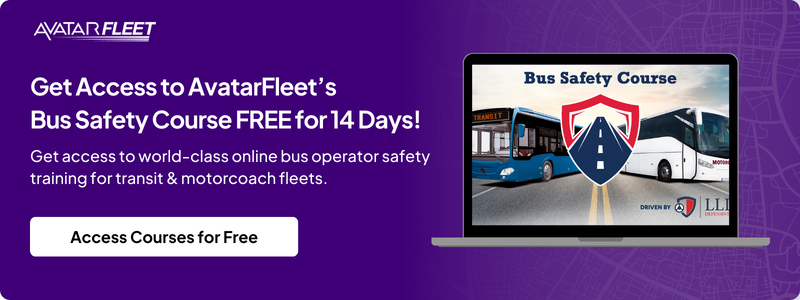Top 4 Mistakes Companies Make When Choosing a Bus Driver Safety Program
John Kuder
January 2, 2024
If you’re a busing operation in need of safety training, you might be wondering where to begin. Do you make your own? Do you go for the cheapest option you can find? Or, if you’re big enough, do you contract out to a firm who will create something custom?
Using the right bus driver training program can be the difference between cutting costs in half and going belly-up from a nuclear verdict. Worse yet, it could be the difference between saving lives and someone losing their life on your bus.
In our several decades of experience helping busing operations reduce cost, we’ve seen people make the same errors repeatedly. When you’re trying to decide what safety solution is right for you, you must avoid these four common mistakes.
Trying to Do Too Much on Their Own
![]() With the cost of bus operator training, it might be tempting to try to make something on your own. Afterall, you know the industry and you know what your bus drivers need to learn. Why not save the money?
With the cost of bus operator training, it might be tempting to try to make something on your own. Afterall, you know the industry and you know what your bus drivers need to learn. Why not save the money?
In very unique circumstances, it can be worthwhile to develop your safety program yourself. However, it’s not as cheap as you think. It takes dozens or potentially hundreds of hours to create an efficient and comprehensive program. Worse yet, you might not be happy with the results you get.
Unless you have a team of instructional designers, programmers, videographers, and industrial organizational psychologists, you’re likely to create a flawed program. Then, in the end, you spent more time and resources creating something that doesn’t work as well as a professionally-produced program would.
The money you spend on high-quality safety training programs will always be worth the investment.
Not Exploring Your Options
![]()
If you work in the transportation industry, you’re busy. You spend all day putting out fires. With that in mind, it’s tempting to do a quick google search for bus safety training and pick the first thing you see. We don’t recommend doing that.
There are so many factors you need to weigh. Just to name a few:
- Content
- Deliver platform
- Style/design
- Cost
- Reviews/testimonials
You won’t be able to compare and contrast if you only have one option. There might be another option that suits you much better than the first one you see.
We recommend having three options that you’re interested in. Each should offer something unique that the other options don’t.
Hyper-Fixation on Cost
![]()
Once you have all your options in front of you, your first instinct might be to pick the cheapest one. Price is a factor, but it’s not the most important one. The most important factor is a program’s return on investment.
Think of it this way. The average bus or motorcoach collision will cost you about $12,000. Therefore, the more accidents a safety program will prevent, the more valuable it is to you (i.e. the better return on investment it provides). Now, let’s compare two safety training program options.
Option A:
-
$500 one-time fee
-
Includes limited-time access to a handful of courses
-
The courses are low quality, but they’re cheap and cover the necessary content
-
Expected number of accidents prevented: 2
-
Expected return on investment: +$23,500
Option B:
- $500/month subscription ($6,000/year)
- Includes world-class safety training courses and access to your own learning management system
- The courses are high-quality and include on-going access for your drivers
- Expected number of accidents prevented: 7/year
- Expected return on investment: +78,000/year
If you go with Option B, you’re spending an extra few thousand dollars, but you’re getting an extra $40,000 in savings per year.
Of course, just because a program is expensive doesn’t mean it’s better. However, the point is that cost is just one factor. If you only look at the immediate cost, you could be missing out on exponential savings.
And full disclosure, option B is our online program The Bus Safety Course. You can get free access if you visit our website.
Starting Off on The Wrong Foot
If you’ve read Stephen Covey’s acclaimed book 7 Habits of Highly Effective People, this will ring a bell: start with the end in mind.
You don’t want to launch into solutions without first considering your goals. A few goals you need to consider are:
- How much do you want to reduce your accident numbers by?
- How quickly do you need accident numbers to go down?
- What specific types of accidents are most important for you to prevent
(i.e. what accidents happen the most and cost you the most money?) - How do you plan to deliver the training content?
If you start by making a plan and setting goals, you can avoid false starts and wasting time with safety programs that won’t work for you.
How Should You Get Started?
If you need a safety training program, time is of the essence. Every moment you waste is another moment one of your drivers is at risk of causing an accident. At the same time, you don’t want to run full steam ahead into a program that isn’t right for you.
The first place to start is set by setting your goals and establishing a budget. The next step is to consider your options. There are dozens of solid off-the-shelf options available for bussing companies. If you want to sign up for free access to one of the best available, follow this link to the Bus Safety Course.
Sign up for our newsletter
Get the latest articles on all things transportation delivered straight to your inbox.
Schedule a live demo

